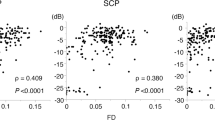Abstract
Blood-retina barrier (BRB) permeability and its relation to the progression of diabetic retinopathy was studied over an 8-year period in 50 insulin-dependent diabetic patients. Initially, the patients underwent an ophthalmological examination, including measurement of best corrected visual acuity, fundus photography and vitreous fluorometry for determination of BRB permeability. After 8 years the patients were reexamined and their retinal status and clinical course were evaluated. We found a positive correlation between a high initial permeability value and an unfavorable clinical course using the parameter photocoagulation. A decrease in follow-up visual acuity was also associated with high initial permeability; however, this correlation was not statistically significant. A significant difference in mean blood pressure was found between values measured in laser-treated patients vs a group that did not undergo such therapy. Thus, in patients showing the same initial retinal morphology, high permeability seems to indicate an unfavorable disease course. The extent to which BRB permeability can be a valuable supplement to fluorescein angiography and three-mirror examination in the clinical decision process needs to be further evaluated.
Similar content being viewed by others
References
Cunha-Vaz JG (1979) The blood-ocular barriers. Surv Ophthalmol 23:279–296
Dalgaard P, Barker VA, Lund-Andersen H (1989) Vitreous fluorophotometry: mathematical analysis of the effect of peripheral leakage on axial scans. Invest Ophthalmol Vis Sci 30:1522–1526
Early Treatment Diabetic Retinopathy Study Group (1985) Report 1. Photocoagulation for diabetic macular edema. Arch Ophthalmol 103:1796–1806
Ghosh G, Schulenberg WE, Kohner EM (1988) Argon laser photocoagulation in preproliferative retinopathy (ARVO abstract). Invest Ophthalmol Vis Sci 29:262
Kohner EM, McLeod D, Marshall J (1982) Diabetic eye disease. In: Keen H, Jarret J (eds) Complications of diabetes, 2nd edn. Edward Arnold, London, pp 19–108
Krogsaa B, Lund-Andersen H, Mehlsen J, Sestoft L (1986) The blood-retinal barrier permeability to fluorescein in normal subjects and in juvenile diabetics without retinopathy. Acta Ophthalmol 64:173–179
Krogsaa B, Lund-Andersen H, Mehlsen J, Sestoft L (1987) Blood-retinal barrier permeability versus diabetes duration and retinal morphology in insulin dependent diabetes mellitus. Acta Ophthalmol 64:173–179
Larsen M, Hommel E, Parving H-H, Lund-Andersen H (1991) Protective effect of captopril on the blood-retinal barrier in normotensive insulin dependent diabetic patients with nephropathy and background background retinopathy. Graefe's Arch Clin Exp Ophthalmol (in press)
Lund-Andersen H, Krogsaa B, Cour M, Larsen J (1985) Quantitative vitrous fluorophotometry, applying a mathematical model of the eye. Invest Ophthalmol Vis Sci 26:698–710
Lund-Andersen H, Larsen M, Larsen H-W, Dalgaard P, Hommel E, Parving H-H (1989) Vitrous fluorophotometry as a possible predictor of the development of diabetic retinopathy: a pilot study. In: Cunha-Vaz JG, Leite EB (eds) Ocular fluorophotometry and the future. Kugler & Ghedini, Amsterdam, pp 165–167
Maurice DM (1985) Theory and methodology of vitrous fluorophotometry. Jpn J Ophthalmol 29:119–130
Parving H-H, Larsen M, Hommel E, Lund-Andersen H (1989) Effect of antihypertensive treatment on blood-retinal barrier permeability to fluorescein in hypertensive type 1 (insulin-dependent) diabetic patients with background retinopathy. Diabetologia 32:440–444
Waltmann SR (1984) Sequential vitrous fluorophotometry in diabetes mellitus: a five year prospective study. Trans Am Ophthalmol Soc 82:827–849
Zeimer RC, Blair NP, Cunha-Vaz JG (1983) Vitreous fluorophotometry for clinical research I & II. Arch Ophthalmol 101:1753–1761
Author information
Authors and Affiliations
Additional information
Offprint requests to: C. Engler
Rights and permissions
About this article
Cite this article
Engler, C., Krogsaa, B. & Lund-Andersen, H. Blood-retina barrier permeability and its relation to the progression of diabetic retinopathy in type 1 diabetics. Graefe's Arch Clin Exp Ophthalmol 229, 442–446 (1991). https://doi.org/10.1007/BF00166307
Received:
Accepted:
Issue Date:
DOI: https://doi.org/10.1007/BF00166307




